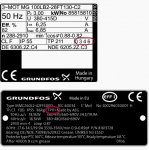You are using an out of date browser. It may not display this or other websites correctly.
You should upgrade or use an alternative browser.
You should upgrade or use an alternative browser.
Manual starter for 1HP
- Thread starter faresos
- Start date
- Status
- Not open for further replies.
Some at that small size have their own built in thermal protection.You need overload protection 430.32(D) > 430.32(B)
You need overload protection 430.32(D) > 430.32(B)
That's what I thought but if the fan was provided with internal overload protection as part of the fan do we still need the starter? How about if we have a fused disconnect switch where the fuse is sized at 125% of the FLA to provide overload and short circuit protection, would a starter still be required?
kwired
Electron manager
- Location
- NE Nebraska
- Occupation
- EC
No and no. The disconnecting means and the motor controller are the same thing in that case.That's what I thought but if the fan was provided with internal overload protection as part of the fan do we still need the starter? How about if we have a fused disconnect switch where the fuse is sized at 125% of the FLA to provide overload and short circuit protection, would a starter still be required?
May not be good design decision, someone could easily replace your 2.5 -3 amp fuse with a 30 amp fuse, plus it may not react as quickly to single phasing conditions as some overload assemblies might.
petersonra
Senior Member
- Location
- Northern illinois
- Occupation
- Semi-retired engineer
Can a disconnect switch be used as On/Off operation for 1HP , 480V-3-Phase cooling fan (fan model number: AIRMAX AM-30GP) or we need to provide a manual starter with overload protection? I thought this fan came with controller but that wasn't the case.
Thanks in advance
The answer is a qualified "yes".
As long as the end installation meets all the requirements, you can do whatever you want.
Is the DS rated for make-break? Some are not.
- Location
- San Francisco Bay Area, CA, USA
- Occupation
- Electrical Engineer
Start by looking at the actual motor nameplate. If it has internal thermal protection, it MUST say so, either with words or sometimes it is abbreviated as "TP" with or without numbers after it.


If you don't see anything showing that it is thermally protected, you must assume it is not and provide it externally. Fuses can technically be used, but it isn't a good idea.


If you don't see anything showing that it is thermally protected, you must assume it is not and provide it externally. Fuses can technically be used, but it isn't a good idea.
kwired
Electron manager
- Location
- NE Nebraska
- Occupation
- EC
:thumbsup:Start by looking at the actual motor nameplate. If it has internal thermal protection, it MUST say so, either with words or sometimes it is abbreviated as "TP" with or without numbers after it.
View attachment 22254
View attachment 22255
If you don't see anything showing that it is thermally protected, you must assume it is not and provide it externally. Fuses can technically be used, but it isn't a good idea.
Common application where fuses get used a lot around here is for fertilizer injector pumps on irrigation systems. They are typically 1/2 HP 480 volts, nameplate amps usually right about 1 amp. 1.25 amp fuse probably ideal, but typically are more expensive and a 2 amp fuse seems to be most commonly used, which I sort of am OK with. but then you always run into some where they put 6 amp fuses in them, and then wonder why the motor burned out:huh:
Lets see it can run at near locked rotor current without blowing the fuse, but I don't know why.
- Status
- Not open for further replies.

